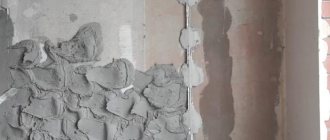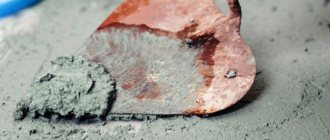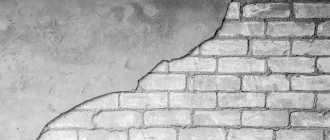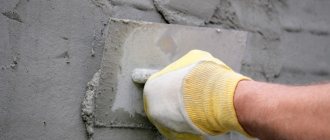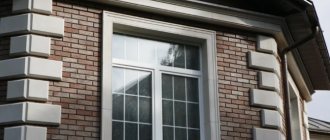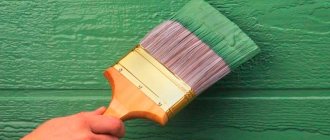Before you make a total renovation or create an intriguing accent in the interior, you need to beat the plaster down to the brick. The whole process is divided into several stages. First, they examine the base of the finish for strength, prepare the room and proceed directly to the elimination of the dilapidated layer. It should be remembered that these works lead to dust and noise. The dismantling process is carried out within the time strictly permitted by law, otherwise conflicts with neighbors cannot be avoided.
How do you know how durable plaster is?
Removing plaster from wall surfaces begins with deciding on a fragmentary or complete change of coating. The entire area of the room is examined and it is found out how firmly it is fixed to the brick wall. To do this, check the plaster layer using a spatula or scraper blade. If the decorative plaster is destroyed in one or two places, then the weakened areas are beaten off or covered with a composition that includes fine-grained sand.
If lime or cement mortar falls away when the trellises are removed, then it is not possible to reconstruct this covering. The finishing layer should be beaten off without any residue and a fresh one should be applied. To check the stability of plastered slopes, ceilings and brick walls, an acoustic method is used - tapping the surfaces with the handle of a hammer. In areas where the coating has moved away from the base, a dull, unclear sound is heard.
If traces of mold are visible in the room, it is important to remove the contaminated coating not only in these areas, but also to cover the surrounding areas by about half a meter along the contour. Mold and grease stains are eliminated by excision and washing with special means. The resulting depression is covered with new plaster.
Any cracks and chips in the ceiling or wall coverings are widened into a wedge-like shape, moistened with water, plastered and washed. Plaster is applied in several stages. A solution of 1/3 of the groove volume is applied to the brick. After drying, fill 2/3 full. Allow to dry again, and at the end the flaw is completely covered.
In what cases may such an operation be required?
When carrying out a major renovation, we evaluate the condition of the finish on the walls and make a decision on whether to preserve, repair, or remove it. If the layer of plaster is severely damaged, then sometimes the ideal solution is to break it completely, reaching the brick or concrete wall, since repairs will become too labor-intensive.
Sometimes, as part of a major renovation, we want to implement a radically different concept for decorating a room, and then the only option is to completely clean the walls, gaining access to them, then carry out insulation and finish everything again in accordance with the plan. For example, old plaster must be removed when installing heavy elements such as tiles and natural stone, since the base for them must be as strong and reliable as possible.
Important! Sometimes it may be necessary to remove not all the plaster, but to clear part of the wall from it. This happens when the wallpaper is unsuccessfully dismantled, the coating is otherwise damaged, or when greasy stains form that cannot be removed in any other way.
How to remove plaster from brick surfaces?
Before removing the plaster, you need to cover the windows with film.
Before clearing the surface of the finish, make a groove down to the brickwork. Check the quality of the brick wall on which the mortar will be applied. If the foundation is not solid enough and collapses with a weak blow, then they abandon this endeavor, since the final result will be disastrous. Before beating the plaster, they prepare the room - take out the furniture, cover the windows and doorways with film, because dust is generated during the process.
The worker must protect his respiratory system from dust with a special mask, and his eyes with goggles.
After preparation, the process of knocking down the finishing from the brick wall begins. The plaster is completely or partially dismantled. Areas with defects or the entire area are beaten with a hammer or other hand tool. The damaged areas will disappear instantly. Using a metal spatula or scraper. The remaining hard areas are moistened. To do this, use a brush-mop or rag and tap the surfaces again with a hammer.
Special devices
You can use a belt sander for this job.
When the layer is difficult to knock down manually, use a puncher, which is equipped with the “impact” option. The instructions for each model of electrical device indicate how to quickly remove the plaster, but the technique is simple - a drill is inserted into the chuck, and the toggle switch is placed in the “impact” position. You can trim the finish using a grinder with a cutting disc. On the plaster floors, cuts are made in both the transverse and longitudinal directions. Then use hand tools, such as a scoop-scraper, spatula. Building materials stores sell electrical devices with which you can remove the plaster layer from a brick wall:
- LShM - belt sander,
- Angle grinder - angle grinder,
- Interskol PShM.
Manual cleaning of brick walls
You can remove old plaster using a hammer or a sharpened chopping tool. This will require strength and patience, because the process is long and difficult. After rough removal of the finishing layer, its particles or scraps may remain on the surfaces. To fight them off, you need to take a wire brush. It is recommended to start this work from the top so as not to contaminate the walls that have been cleaned of plaster.
Dismantling methods
There are two ways to dismantle the old layer of plaster - manual and mechanical.
Reference. The weight of dry plaster when dismantling 1 m2 with a thickness of 10 mm will be:
- 9.5-10 kg for gypsum materials;
- 17-18 kg for cement compositions.
Depending on the chosen method for work, you will need the following tool:
Chisel or chisel
Sledgehammer, ax or hammer
Spatula, scraper or scraper
Electric tools: hammer drill, grinder (grinder)
Important! Do not neglect safety rules; your life and health depend on their compliance. When working, be sure to use protective gloves, goggles and a respirator.
Where should I put the garbage?
Disposal of old plaster remains is important. It is not always possible and time to remove it, which is due to the range of special landfills and the work of public utilities. In apartment buildings, removal is possible only by special transport. In private homes, the problem is easier to solve: waste can be reused. Cement-sand screed is used as a material for pouring paths, a filler in concrete mixtures for forming platforms and paths. Clay plaster is saved for reuse. There is no need to mix the solution, since the proportion of sand and clay has already been measured, the materials are thoroughly mixed, it is enough to saturate them with moisture. Remains of gypsum plaster are used as insulation for the construction of floors of utility buildings.
Permanent address of the article
We work using an automatic tool
- Hammer. We switch the drill to impact mode and insert it into the thickness of the plaster at an angle of 80 degrees. Having reached the base, we shift the slope to 40 degrees, after which we move the tool to the side, destroying the plaster along the way;
- Bulgarian. The wall is divided into squares with sides of half a meter, along the perimeter of which grooves are cut. The latter will become the starting point for working with a hammer drill;
- Sander. On the surface of the tool there are rollers with spikes, which allows you to remove the plaster if its strength is relatively low. The advantage of this method is that it saves effort, but the disadvantage is a large amount of dust.
In general, the work about automatic means can be said that the grinder has relatively little efficiency in cutting plaster. Well, with a hammer drill, you need to take into account that during operation there is a lot of noise, and the duration of the process is very long, so the neighbors will have a hard time. Therefore, it is still better to try to get rid of it manually.
Important! We can radically reduce the amount of dust during work by pre-wetting the walls with water. Use this trick with any method of removing plaster, as it also softens the coating, making it easier to remove.
Articles on the topic
Staircase in a brick house - types, features of the foundation, instructions, advice from masons
Reinforcement of brickwork - types, materials, instructions, advice from masons
How to install a door in a brick house - options, installation, instructions, advice from masons
Service life of a brick house and how it can be increased?, instructions, advice from masons
Cladding a house with bricks - how to calculate how much material is needed, instructions, advice from masons
Switching from brick to sandwich - installation, pros and cons, instructions, advice from masons
Waterproofing a brick plinth - horizontal, vertical, instructions, advice from masons
Mosaic with bricks - preparation, masonry features, instructions, advice from masons
Reviews ()
Sequence of the chop
- First, the surface of the wall is tapped with a plaster spatula or hammer. In this way, the strength of the old plaster is determined. A dull sound upon impact indicates good adhesion between the plaster and the wall. Sections of the wall where a ringing sound is heard must be dismantled.
- After identifying the defective parts, the plaster is dismantled; prices for this preparatory stage before repair largely depend on the tools used.
- Now you need to remove the plaque.
- Next, another inspection of the walls is carried out to ensure the final removal of the plaster.
- Cleaning and removal of construction waste is carried out.
Our company guarantees high-quality performance of all work related to plastering. We offer professional dismantling of plaster, the price per m2 of which is determined based on the total volume of work. Our company’s specialists can also carry out the dismantling of partitions and dismantling of walls, as well as other repair work.
Cleaning fabrics and leather from marker
The main problem is that the color penetrates quickly and deeply into the tissue structure. It becomes more difficult to get him out. If your favorite jacket or T-shirt is damaged, you can try soaking the item in bleach. But this method is only suitable for light-colored fabrics that are not too sensitive to aggressive chemicals. For example, delicate satin cannot be cleaned this way. But you can try a mixture based on milk, vinegar and borax, which are taken in equal proportions and applied to the stain. After ten minutes, the product is washed off.
Clothing made from thick fabrics can be cleaned with acetone or alcohol. Dermantin or genuine leather - there is no difference. This method can be used for leatherette shoes, but not for suede. In the latter case, it is better to take the items to the dry cleaner.
It is important to remember to wipe the area with a damp cloth, removing traces of the product so that it does not continue to work, corroding the material. You need to be careful with the seams, as they absorb the color. The movements should not be rubbing, but as if collecting dirt.
Cotton items can be cleaned with lime or lemon juice. Alcohol is more suitable for carpet. But in this case, the stain does not need to be rubbed hard so as not to smear it on the fabric. To enhance the effect, you can apply hairspray on top.
Types of events
Classification of types of cleaning is made according to several criteria. Taking into account seasonality , they distinguish between summer, which is characterized by the removal of a large amount of foliage and dust, and winter , with ice, snow and ice.
If complex activities are carried out with simple tools and devices - this is manual cleaning, using special equipment for sweeping, clearing snow, loading garbage - mechanized.
According to the frequency of events, they are distinguished:
- Primary – precedes regular cleaning; a level of purity is achieved that will be constantly maintained.
Plastering interior walls using different prices
In your opinion, is it possible to use the trace at the same time? prices for one volume: I will write in order, but it is important for me to understand the plaster
1. 61-2-7 plaster repair 2. 62-2-8 +10 mm add to 61-2-07 3. 15-04-006-04 primer 4. 15-02-016-03 improved plaster 5. 10 -01-092-01 antiseptic treatment 6. 61-1-9 continuous leveling Vetonit 7. 15-04-007-03 improved painting for some reason on prefabricated structures.
Regarding plaster, point 4 seems redundant, what is your opinion? If possible, with reference to the “source of opinion! ))
Non-working days, weekends and holidays in November 2022
According to the production calendar for 2022, a long weekend was planned in November from the 4th (this is a holiday) to the 7th inclusive (November 6 and 7 are Saturday and Sunday, and the 5th is a postponement of the day off from January 2 ). But due to the situation with coronavirus, the President declared non-working days throughout the country from October 30 to November 7 (Decree No. 595 of October 20, 2021). At the same time, regions themselves have the right to extend the period of non-working days and begin it earlier than October 30.
Thus, it turned out that at the beginning of November, non-working days coincide with holidays and weekends. At the same time, not only regions can independently set the duration of non-working days, but organizations also have the right to decide whether employees should go to work during the “anti-Covid holidays” (with the exception of organizations that are prohibited from working during this period by decree of regional authorities).
In such a situation, citizens who usually receive social payments at the beginning of the month are puzzled by the question of whether banks, post offices, the Pension Fund, social security and other organizations on which they depend for receiving social payments will work, and whether they will be able to receive money on time due to non-working days and holidays.
Plaster beating - estimator forum - estimator ru - estimate portal - everything for the estimator - estimate
Quote
(veronica)
the resources in the mechanisms take into account the compressor, but it doesn’t care whether the base is used for beating or the plaster
come on, you’re talking nonsense...can’t a jackhammer be like a hammer drill and compressed air electricity?))))) there are different types of hammers and the force of impact is also by the way...
Quote
(veronica)
I wouldn't add plaster trim separately. Although I had a case where the base under the tiles was dismantled exactly as plaster beating. But there were reasons for this, and this was supported by an act of inspection of the object agreed upon by the commission
But what for the commission? Did you check if it would fall off somewhere with the plaster or something? the prices, as I understand it, reflect the process... they removed the tiles (while preserving them in good condition) and prepared the base (beating up the plaster) two processes or just knocking off the plaster along with (without saving) one process, one price and the resources, as far as I remember, are not subject to adjustment... so we We’ll soon get to the use of cranes in prices))))
I may be wrong, but that's no reason to stop thinking. (House MD)
The heart kept repeating: “The main thing is truth,” the brain understood: “Who needs this?” (House MD)
Before you make a total renovation or create an intriguing accent in the interior, you need to beat the plaster down to the brick. The whole process is divided into several stages. First, they examine the base of the finish for strength, prepare the room and proceed directly to the elimination of the dilapidated layer. It should be remembered that these works lead to dust and noise. The dismantling process is carried out within the time strictly permitted by law, otherwise conflicts with neighbors cannot be avoided.
